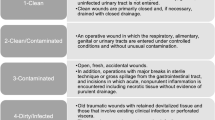Abstract
Background
Poststernotomy mediastinitis is a serious complication after open heart surgery. There are currently no specific guidelines with regards to standard treatment.
Methods
This is a prospective cohort study using a source population of 7842 patients who underwent open heart surgery. Between 1999 and 2010, 83 patients were diagnosed with mediastinitis, of which 24 patients underwent reconstruction with bilateral pectoralis major advancement flap. All surviving patients were seen at follow-up, and postoperative functional level was examined. The closing date was October 1, 2011.
Results
Median follow-up time from primary operation was 6.0 (1.6–15.5) years. Median follow-up from postsurgical mediastinitis was26 5.4 (0.4–12.4)years. There was no early mortality, and 22 patients were discharged with complete wound closure and infection control. Quality of life questionnaires revealed significant morbidity with chronic pain and reduced mobility, but despite this, patients were satisfied with their overall health outcome.
Conclusions
Mediastinitis remains a serious postoperative complication after open heart surgery accounting for significant morbidity and mortality. Treatment of deep sternal wound infection by pectoralis major flap reconstruction gives excellent wound closure. Follow-up showed that these patients were multimorbid with reduced quality of life as measured.
Level of Evidence: Level IV, therapeutic study.




Similar content being viewed by others
References
Loop FD, Lytle BW, Cosgrove DM et al (1990) Sternal wound complications after isolated coronary artery bypass grafting: early and late mortality, morbidity and cost of care. Ann Thorac Surg 49:179–187
Feo D, Renzulli A, Ismeno G et al (2001) Variables predicting adverse outcome in patients with deep sternal wound infection. Ann Thorac Surg 71:324–331
Francel TJ, Kouchoukos NT (2001) A rational approach to wound difficulties after sternotomy: reconstruction and long-term results. Ann Thorac Surg 72:1419–1429
Thurer RJ, Bognolo D, Vargas A, Isch JH, Kaiser GA (1974) The management of mediastinal infection following cardiac surgery: an experience utilizing continuous irrigation with povidone-iodine. J Thorac Cardiovasc Surg 68:962–968
Gummert JF, Barten MJ, Hans C et al (2002) Mediastinitis and cardiac surgery—an updated risk factor analysis in 10,373 consecutive adult patients. J Thorac Cardiovasc Surg 50:87–91
Jurkiewicz MJ, Bostwick J 3rd, Hester TR, Bishop JB, Craver J (1980) Infected median sternotomy wound. Successful treatment by muscle flaps. Ann Surg 191:738–744
Argenta LC, Morykwas MJ (1997) Vacuum-assisted closure: a new method for wound control and treatment: clinical experience. Ann Plast Surg 38:563–576
Garner JS, Jarvis WR, Emori TG, Horan TC, Hughes JM (1988) CDC definitions for nosocomial infections. Am J Infect Control 16:128–140
Risnes I, Abdelnoor M, Almdahl SM, Svennevig JL (2010) Mediastinitis after coronary artery bypass grafting risk factors and long-term survival. Ann Thorac Surg 89:1502–1509
Gamel AE, Yonan NA, Hassan R et al (1998) Treatment of mediastinitis: early modified Robicsek closure and pectoralis major advancement flap. Ann Thorac Surg 65:41–47
Ennker IC, Pietrowski D, Vöhringer L et al (2009) Surgical debridement, vacuum therapy and pectoralis plasty in poststernotomy mediastinitis. J Plast Reconstr Aesthet Surg 62:1479–1483
Gao J, Wang YL, Lu SQ et al (2010) Management of sternal osteomyelitis and mediastinal infection following median sternotomy. Chin Med J 123:2803–2806
Brito Jde D, Assumpção CR, Murad H et al (2009) One-stage management of infected sternotomy wounds using bilateral pectoral pectoralis major myocutaneous advancement flap. Rev Bras Cir Cardiovasc 24:58–63
Wong CH, Senewiratne S, Garlick B, Mullany D (2006) Two-stage management of sternal wound infection using bilateral pectoralis major advancement flap. Eur J Cardiothorac Surg 30:148–152
Eyileten Z, Akar AR, Eryilmaz S et al (2009) Vacuum-assisted closure and bilateral pectoralis muscle flaps for different stages of mediastinitis after cardiac surgery. Surg Today 39:947–954
Milano CA, Georgiade G, Muhlbaier LH, Smith PK, Wolfe WG (1999) Comparison of omental and pectoralis flaps for posternotomy mediastinitis. Ann Thorac Surg 67:377–380
Tomos P, Lachanas E, Michail PO, Kostakis A (2006) Alternative bi-pectoral muscle flaps for postoperative sternotomy mediastinitis. Ann Thorac Surg 81:754–755
Klesius AA, Dzemali O, Simon A et al (2004) Successful treatment of deep sternal infections following open heart surgery by bilateral pectoralis major flaps. Eur J Cardiothorac Surg 25:218–223
Eriksson J, Huljebrant I, Nettelblad H, Svedjeholm R (2011) Functional impairment after treatment with pectoral muscle flaps because of deep sternal wound infection. Scand Cardiovasc J 45:174–180
Ringelman PR, Vander Kolk CA, Cameron D, Baumgartner WA, Manson PN (1994) Long-term results of flap reconstruction in median sternotomy wound infections. Plast Reconstr Surg 93:1208–1216
Daya M, Barnes N (2009) Use of VAC therapy and sternal plating in the treatment of sternotomy wound dehiscence. Eur J Plast Surg 32:287–291
Schols R, Lauwers T, Geskes G, van der Hulst R (2011) Deep sternal wound infection after open heart surgery: current treatment insights. A retrospective study of 36 cases. Eur J Plast Surg 34:487–492
Ethical standards
The study has been approved by the appropriate ethics committee and have therefore been performed in accordance with the ethical standards laid down in the 1964 Declaration of Helsinki and its later amendments. Patients gave their informed consent prior to their inclusion in the study. Details that might disclose the identity of the subjects under study were omitted.
Conflict of interest
None
Author information
Authors and Affiliations
Corresponding author
Rights and permissions
About this article
Cite this article
Rashidi, M., Barstad, M.R., Brunborg, C. et al. Bilateral pectoralis muscle advancement flap in the management of deep sternal wound infection: a single clinic study of clinical outcome and postoperative quality of life. Eur J Plast Surg 37, 423–430 (2014). https://doi.org/10.1007/s00238-014-0967-z
Received:
Accepted:
Published:
Issue Date:
DOI: https://doi.org/10.1007/s00238-014-0967-z




